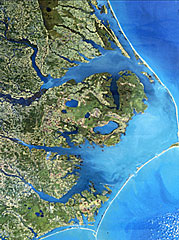
(Courtesy of Hans W. Paerl,
http://www.marine.unc.edu/Paerllab and
http://www.marine.unc.edu/Neuse/modmon)
(Click for larger image)

|
The Albemarle-Pamlico Sound is located in North Carolina and is the second largest estuary in the United States. The region's watershed is approximately 30,000 square miles. The Albemarle-Pamlico Sound encompasses over 9,000 miles of freshwater rivers and streams and over 1.5 million acres of brackish, estuarine waters. The Chowan, Roanoke, Pasquotank, Tar-Pamlico, and Neuse are five major river basins that flow into the Sounds. There are seven sounds that make up the estuarine system. They are the Albemarle, Currituck, Croatan, Pamlico, Bogue, Core and Roanoke. The Albemarle-Pamlico Sound supports a variety of habitats including wetlands, rivers, and creeks. In these habitats, there lives a diversity of organisms. There are nursery areas located in the creeks and embayments of the estuarine system that are important to over 75 species of fish and shellfish. Shellfish beds are important as well to support the fisheries industry. However, there has been a decline in shellfish beds as a result of physical disturbance. Anadromous fish, fish that live in the oceans but migrate up freshwater rivers to spawn, use the estuarine system as a habitat for spawning. These fish include striped bass, shad and herring. The Albemarle-Pamlico estuarine system is economically important to the region. Commercial fishing, tourism, recreation, and resort development are activities within the Sound that are economically important to the region. Ninety percent of the fish and shellfish caught by commercial fishermen rely on the estuary as a nursery habitat. The Sound also provides food, jobs and a mode of transportation for the people that live within the estuarine area.
|